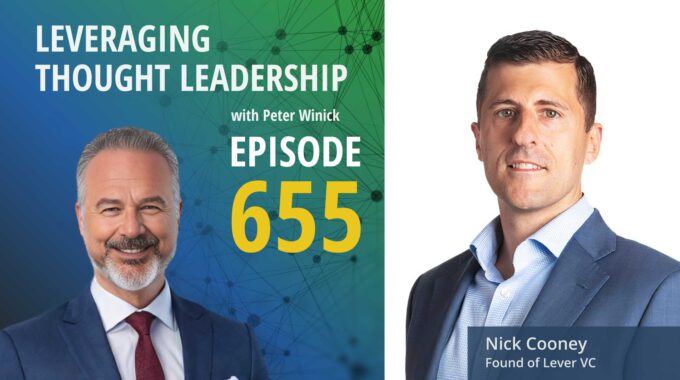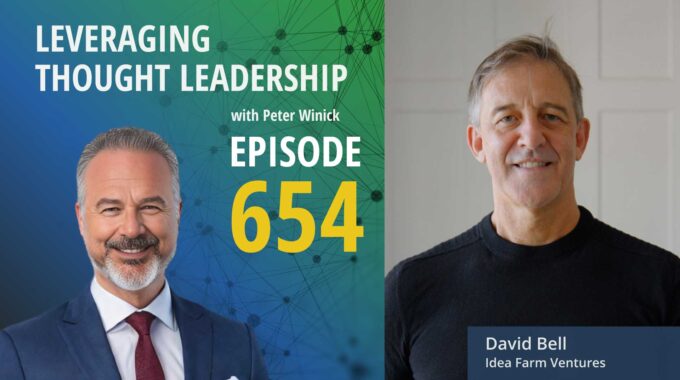Where Human Ingenuity Meets Machine Intelligence AI is transforming thought leadership—but not by replacing humans…
Communication for Powerful Thought Leadership | Jane Hanson

Learning to be a better communicator in any medium.
An interview with Jane Hanson about improving the communications of thought leadership.
Your main goal as a thought leader is to get your insights into the world.
But if your communication doesn’t live up to its message, then your thought leadership will gather dust on a shelf
To offer insights that elevate your communication, I’ve invited Emmy Award winning Journalist Jane Hanson to join me for today’s podcast. In addition to being a journalist, Jane is a coach with thirty years of helping people communicate more clearly, more efficiently, and with greater panache.
Jane shares a recent study that revealed the average American has an eight second attention span. Eight seconds! That means thought leaders have to be able to take advantage of a tiny flicker of time to communicate ideas quickly and clearly. Often, thought leaders are better at communicating in a single medium. However, to be successful, you’ll need to master many different mediums – because different audiences have different preferences! Jane shares great advice for learning new mediums, and offers elements to strengthen your message in any form.
Jane shares why thought leaders should follow in the footsteps of comedians, rehearsing their material over and over, working on timing, inflection, and nuance. If you are deeply familiar with your strongest talking points, speaking in front of crowds will become easier, and your speeches will appear more natural. Plus, we learn how to get personal with an audience by mingling and getting to know them before an event, adding touches that make your keynote feel tailor-made for that audience.
Jane shares so much advice for becoming a better communicator.
You are going to want to listen to the episode, read the transcript, and take notes!
Three Key Takeaways:
- Good communication is the heart and soul of thought leadership.
- Tailor your message to the audience to increase clarity and impact.
- Strife to delivery your ideas with passion, confidence, and comfort.
If you need a strategy to bring your thought leadership to market, Thought Leadership Leverage can assist you! Contact us for more information. In addition, we can help you implement marketing, research, and sales. Let us help you so you can devote yourself to what you do best.

Transcript
Peter Winick And welcome, welcome, welcome. This is Peter Winick. I’m the founder and CEO at Thought Leadership Leverage and you’re joining us on the podcast, which is Leveraging Thought Leadership today. My guest is Jane Hanson, and Jane is an Emmy Award winning television journalist and a coach. And she has spent over 30 years helping people learn to communicate. She’s won nine Emmys. She was correspondent of the year. She has been involved in lots of charities, including the March of Dimes, Susan B. Komen. She was co-anchor of Today in New York. And if I continued to read her bio, we would run out of the 20 minutes that we have.
Jane Hanson And I don’t know. I don’t want to hear anymore.
Peter Winick And Jane knows all this anyway. So, Jane, if.
Jane Hanson I do, I do.
Peter Winick They’ll google you, when – when we’re done here. But anyway, welcome aboard. Thank you for joining us today.
Jane Hanson Thank you so very much for being here. This is one of my favorite subjects, talking about thought leadership, but leveraging and what is thought leadership and how do you communicate? Well in all those things, because in today’s world, it’s such an interesting place to be.
Peter Winick Yeah, no, exactly. So I want to hear the thought I was having getting ready for today. So a lot of people think thought leadership and they get a little bit overwhelmed. Oh, my God, I’ve got to write an article. Oh, my God. I’ve got to write a book. You know, it’s a heavy lift, right? It’s almost like, you know, if you started to work out and the first thing that you did was a marathon, it’s going to be exhausting and overwhelming. But I think that there’s lots of opportunity to use thought leadership in terms of talking points, bullet points, conversations, etc.. So maybe connect the threat of your work or mine of sort of how do you use thought leadership and communicate that effectively in a natural way?
Jane Hanson Well, thought leadership and leadership doesn’t magically happen because one day you say, I think I’m going to be one thought. Leadership is it’s building upon who and what you are. And I believe that the heart and soul of it is good communication, because I I’ve talked to a lot of people that are called thought leaders in whatever expertise theory, and we discussed how did you get to that place where you’re considered the woman, the man, the expert? Right. To a person, they say it has nothing to do with me aiming to become something. It’s just that I got really good at telling this story and doing it in a way that has confidence and yet knowledge and all of that put into a place and we might call it wisdom, perhaps that’s sure. But but.
Peter Winick But stay there because I think there are some folks that are that are really awesome amazing wise thought leaders. But because for whatever reason, they’re researchers, they’re academics, they’re introvert, whatever the reason is, and it doesn’t matter that they communicate best via words on a page, right? They write really well, they research really well, but then you ask them to bring it to life, either conversationally, something like this on a podcast or keynote. And they’re awful, right? It’s just not who they are or what they’re about or those muscles aren’t developed.
Jane Hanson It’s interesting. You know who Simon Sinek is?
Peter Winick Yes.
Jane Hanson Simon has got billions of viewers of his YouTube videos. He’s considered to be one of the best communicators in the world, but he has been known to say that he’s a total introvert, and if he’s at your party, you’ll be the guy sitting over in the corner waiting for somebody to come to talk to him.
Peter Winick Sure.
Jane Hanson So here’s the thing is that in our world today, people don’t take a long time to read a white paper or to read anything or to read anything. I can’t tell you the number of authors I’ve interviewed who I’ll ask them and say something like, You know, I don’t understand what you mean. On page 64, when you said this and the go, you actually read the book and they’re out there and they’re on a speaking tour all over the country, and I’m like the first person they’ve encountered that’s actually worth so and that has to do with attention spans, which on average in the United States today are 8 seconds. And we’ve got this this overstimulated world with the social media and with everything being so immediate and so quick. So if, you know, first of all, you got to think, what’s the purpose behind becoming a thought leader? And if your purpose is really true, it’s about taking the information that you have and getting it out into the world because there’s an importance to it, there’s a significance, there’s a need for it. Yeah, if you’re a researcher and you’ve got something that’s got amazing information about a medical process or a integrity, then you got to get it out there. But if you can’t communicate it, then it’s going to sit where it is and nobody will ever know. And we’re missing out on an opportunity to cure a disease or something.
Peter Winick What are some of the. Tips, suggestions, advice, whatever you might have for someone that is really good at communicating. For example, in the written word. But when they bring it to life conversationally or, you know, public speaking or whatever, it’s just not their thing.
Jane Hanson I recently worked with a woman who wrote a book and she was about to go on a tour and scared to death. And she said, I’ve never spoken in public before. I’ve never done a video. I’ve never been in front of a microphone. I’ve never been in front of lives. I’ve never talked to a reporter. And she goes, I’m absolutely scared to death. What do I do? And I said, We’re going to start really simply. And the first thing we’re going to do is you have a lot of information in your book, which I had a book about, you know, medicine and women and that sort of thing. I said, So first we need to think about who you want to reach. And she said, My book is really about helping women manage their health. They said, Bingo, That’s where we start. So the first thing we did is help her create really good messages that she could repeat over and over and over again that she got truly comfortable with saying.
Peter Winick That repetition gives them the comfort to then build on it. And so it’s kind of baby steps.
Jane Hanson And by the way, 87% of the people in this country suffer from something called claustrophobia at one point in their life, which is the fear of public speaking.
Peter Winick Right. Right.
Jane Hanson So a person like this woman I worked with thinks that she’s alone in this feeling.
Peter Winick But the only one. Right?
Jane Hanson Right. But she is not at all. Most of us have it at some point in our life. And if we don’t, maybe we’re dead, you know, because there’s going to be a situation. There’s always something happening. Maybe you get up to give a speech and the mic doesn’t work or you blank out or you get really nervous or you’re in a video situation and the tech goes down and you do it right. I mean, all kinds of crap can happen. And so there’s a lot of things that you can be afraid of, but if you stick to your purpose. So my work with her was a really creating some solid messages that she could then repeat over and over with. Because this isn’t it’s not brain surgery. You could if you’re if you’re out there talking about a book, the message is consistently going to be the same. It’s the audience, the change.
Peter Winick And when you do that with the spoken word or not, even something as formal as a presentation keynote, but just in conversation, you’re meeting somebody someplace, you’re at a cocktail party, whatever, you know, the words that are on the page are different than the words that one uses to speak. Sure. So you have to sort of play with it and say, ooh, does that like, wow, that’s the best chapter in my book. And that’s an awesome opening couple of lines. But when I say it out loud, it’s artificial, it’s clunky, It doesn’t sound like the way someone would make a statement such as that, you know?
Jane Hanson So you change it up to make it real. Yeah. And for example, if you’ve written a book about let’s just use that medical thing about medicine and you’re speaking to doctors, you can use some big multi symbolic words or something that they’re going to understand. But you can’t do that if you’re speaking to a group of, you know, college students that haven’t studied this stuff. So you really have to focus on who am I talking to to make sure the message is clear. And then it has to be in your own words, in your own voice. And so.
Peter Winick If you’re enjoying this episode of Thought Leadership Leverage, please make sure to subscribe. If you’d like to help spread the word about our podcast, please leave a five star review at ratethispodcast.com/ltl and share it with your friends. We’re available on Apple Podcasts and on all major listening apps as well as at ThoughtLeadershipLeverage.com/podcast.
Jane Hanson And then you also have to remember that the questions you’re going to get are always pretty much going to be the same. Like why did you write this book or what’s your purpose? Or what do you want somebody to take away from this? Or tell me instead.
Peter Winick Off point for a moment, Jane Because one of the things that I see a lot with my clients is they’re launching a book as an example, right? And because we all have I mean, you mentioned the eight second thing, and, you know, everybody’s attention spans are short, by the way. Thought leaders are humans, so they’re a subset of that. So therefore, they suffer from that as well. Right. Absolutely. Got to do a, you know, a book launch or a book tour, and they’re going to do whatever pick a number 100 podcasts or keynote or whatever to promote that. Right. And they get so bored with their own stuff himself, play it that they keep switching it up, which is actually somewhat selfish and really doing a disservice to the audience. Right Where you move to a role of your job now is to not intrigue yourself, but to be the evangelist and the messenger of the message and to find the best way to get it out there over and over and over again. And quite frankly, it’s okay. It may bore the hell out of you here.
Jane Hanson The trick. Think like a comedian. Okay. What do I mean by that? So the last show I did at NBC, Joan Rivers was a frequent guest. And so I have been to these little tiny comedy clubs in New York City with Joan, where she would try out material, new material, and she would do it over and over and over and over again. I said, What are you doing? And she goes, I got to get my timing right, and I got to get.
Peter Winick This every word, every nuance right.
Jane Hanson Seinfeld’s Exactly. And I said, Why? And she goes, Because it has to sound fresh and new with every audience. So she’s telling the same joke a hundred times, 500 times a minute. Every single comedian you’ve ever listened to. You hear them and you go, Oh, man, they just made that up. It’s the funniest thing I’ve ever heard. Bottom line is, they’ve already told that same joke 500 times. They find a way to make sure that even when they’re using the same thing over and over, that they can make it sound fresh and new and like spontaneous.
Peter Winick And I think that holds true for amazing keynotes, right? So in my universe, almost all of my clients speak and one group of speakers. I call it the drive by, right? If you walked in at 3 minutes and 22 seconds, they’re talking about it on my plane ride here today. And it’s robotic and it’s they’re not connected to the audience. They’re using client instead of customer, whatever the other one might be at just about the same place at the same time at every keynote. But there’s a connection to the audience. There’s a warmth, there’s a conversational piece to it, because nobody wants to be sitting in an audience feel like, Wow, they’re just talking to furniture.
Jane Hanson Right? Well, so you. So that’s what I mean. You have to think about your audience. I’ll give you another little example, because I just a client of mine just sent me this speech yesterday that she did, which was utterly amazing. And the speech was in Las Vegas. And she even though she had practice and rehearsed her speech dozens of times, she took the very opening. And she when she walked out on the stage, she had on this unbelievable pink dress with these unbelievable shoes that were multicolored. They were just amazing. And she says she said yesterday, when I was in the session, I heard so-and-so talk about his shoes. So I decided to one up him. How do you like my shoes?
Peter Winick That’s pretty good.
Jane Hanson And then she said, And by the way, there’s one other thing. Help her now. She’s in Vegas, right? So she’s using what’s there. And she said in poker and she goes, I’m playing the odds here because these shoes hurt and I got 30 minutes to speak. What do you think my odds are that my feet are going to hold out that long? Then she launched into her speech. But meantime, she’s got the audience laughing and connecting to her.
Peter Winick So that takes a little bit of work. And I and I think, quite frankly, a lot of folks, regardless of the medium, get lazy and fall back on their stuff, right. Fall back on their comfort zone and say it didn’t take her a lot to do that. But I guarantee you over the meal break or whatever I was talking about, Oh, so-and-so in her shoes. Oh my God, that was the cutest thing I ever saw. And oh my God, the lady with, Oh, you’re the lady with the shoes and you’re blah, blah, blah, blah, blah.
Jane Hanson All right. How do you do? Your feet hurt. So that’s one of the things I urge people to do is what I especially, you know, that these in-person events and you could even do it virtually as well. Yes. Which is I say mingle with the audience a little bit, if you can, ahead of time or find out something about them. I know. And then just like because I have done a ton of public speaking in my life and just kind of wander around and I’ll say, Hey, where are you guys from? And then I’ll go, Oh, you know, Oh, it’s his birthday today. And oh, this is happening. And so there’s this. And then as I come out to speak, I immediately make some reference to what I’ve learned from my audience now.
Peter Winick And I think again, going back to the lazy piece, it takes a little bit of work, but not much to find it. Well, go mingle with the group. Hey, say hello. Oh, what are you working on? What are you struggling with? Whatever. And I was talking to Bob in the hallway and he told me the big initiative this year is blah, blah, blah. You’re like, Oh, she’s she years us, right? She gets in.
Jane Hanson Cares, she’s relating to us even if you don’t care. Yeah.
Peter Winick So it was we as we start to wrap up give a little bit of thought and advice as if you were coaching whoever is listening with regards to how to get the most impact out of their thought leadership from a communication standpoint.
Jane Hanson Well, I want to I want to say like three things. It’s about knowing your audience, which we’ve already discussed. The second thing is with your content, make your content really impactful by the words that you choose to use. And also, I love using this fact. The most impactful speech that Abraham Lincoln ever made was the get address right. How long was it?
Peter Winick Oh, I think I remembered that we were. It was like 87 words or something silly.
Jane Hanson No, it’s 272 words. Minutes long. Most wanted. It still has great impact today. So the value of both brevity and being impactful that, well, you’ll always win. And then the third thing, remember that your style and how you deliver. If I say if I say, let’s pretend like I’m Abraham Lincoln and I say we are going to free every slave hop. If you say we are going to free every slave, and you really use your own personal style in the right way, then then it becomes impactful and at the heart and soul of all of that for thought leaders is confidence in what they believe and commitment to their purpose and the comfort of being able to deliver it to this audience as if they’re sitting in their living room.
Peter Winick Well, thank you so much. Awesome stuff. Thank you. This is one I want to go back and read the transcripts. Lots of good stuff in here. Thank you for sharing it.
Jane Hanson You’re very welcome. It was a delight to be with you.
Peter Winick To learn more about Thought Leadership Leverage, please visit our website at ThoughtLeadershipLeverage.com to reach me directly. Feel free to email me at Peter at ThoughtLeadershipLeverage.com and please subscribe to Leveraging Thought Leadership on iTunes or your favorite podcast app to get your weekly episode automatically.





